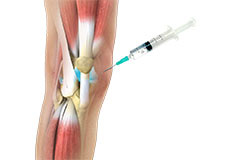Hip and knee joints are the common weight-bearing joints and are also the most commonly affected joints by disease conditions such as arthritis, traumatic injuries or sports injuries. These conditions may affect the joints and impair the mobility as well the quality of life of the patients. All these conditions require appropriate treatment, may be surgical or non-surgical to restore the normal activities. The Non-operative care for the hip and knee includes the use of both nonpharmacological and pharmacological interventions. They are aimed at providing symptomatic relief and improving the quality of life of the patients. They can be used as a treatment option to certain condition or to decrease pain as well promoting functioning and quality of life after the surgical treatment.
Non-pharmacological Intervention
Non-pharmacological interventions may range from simple lifestyle modification or the physical exercises and rehabilitation programs. Some of the non-pharmacological interventions include:
- Weight reduction and physical exercise – The lifestyle changes resulting in weight loss in obese individuals and doing appropriate physical exercises plays an important role in prevention and management of the hip and knee conditions.

The optimal weight (BMI) should be 18.5 to 25. BMI of 25-29 is considered over weight and BMI over 30 is considered as obese.
Exercises are contraindicated in individuals suffering from cardiovascular diseases. Therefore rigorous exercises is not ideal for all patients and must be individualized for every patient and done under the supervision of a trained professional.
- Transcutaneous electrical nerve stimulation – The transcutaneous electrical nerve stimulation (TENS) method involves the use of low-voltage electric impulses to relieve the pain. It is believed to provide pain relief by inhibiting the conduction of pain impulses to reach the receptors in the brain and spinal cord. Patient is made to worn a device and this device generates the impulses that offer pain relief to the patients. Frequency of the impulses, duration of treatment and location of the electrical electrodes on the body are decided by your physician based on the severity of condition as well the response of the patient. Use for at least 4 weeks may provide better pain relief.
It should not be used by patients having pacemaker or cochlear implants, or those suffering from epileptic conditions. It should also not be used during pregnancy.
- Thermotherapy – Thermotherapy involves application of hot or cold packs at the affected area. There is some evidence to support the use of cold therapy in providing symptomatic relief. It is contraindicated in individuals with thermoregulatory impairments. Individuals having peripheral vascular disease, diabetes, cardiovascular disease and hypertension, or who are pregnant should use it with caution.
- Acupuncture – This method involves insertion of sterile needles into specific acupuncture points or pressure points. It is believed that insertion of needles at specific points restore the flow of “qi”, a form of energy and thereby relieves the pain. A modification in acupuncture is electro-acupuncture where the needles are stimulated by and electro-stimulator. Acupuncture performed by trained professionals is considered to be safe and offers pain relief however may have certain risks if treated by untrained professionals.

- Patellar tapping – Patellar tapping is used as a short term treatment particularly when performing normal activities deteriorates the knee condition. The principle behind the treatment is stabilization of knee joint by altering the distribution of stress and joint pressure. The response depends on the strapping technique used and the time for which it is strapped.
- Massage therapy – It is one of the oldest methods of treatment and reduces pain by increasing the circulation of blood and lymph as well by reduction of muscle tension or because of the therapeutic effect of the touch.

Pharmacological Interventions
Pharmacological interventions include management of pain using medicinal preparations such as pain relieving capsules or injections.
- Non-steroidal anti-inflammatory drugs – These are known as NSAIDs and are found to be effective in reducing pain and inflammation of the hip and the knee. Caution must be taken while using NSAIDs for overdosing as they are known to cause hepatotoxicity. Patients with liver diseases must have extreme care while using them. They cause a range of side effects, chances of which increase with the concomitant use of diuretics, angiotensin converting enzyme inhibitors, angiotensin 2 receptor blockers, anticoagulants or oral corticosteroids.
- Weak and strong opioids – Opioids are prescribed when use of analgesic medications or NSAIDs does not offer symptomatic pain relief, if other treatments have intolerable side effects or in whom the surgery is delayed or contraindicated. Though they offer better pain relief they are known to cause side effects such as dry mouth, nausea, vomiting, dizziness and constipation. Overdose may lead to respiratory depression. The dose is reduced slowly otherwise cause withdrawal effects. They are also known for addiction.
- Intra-articular corticosteroid injection – These injections should be given using appropriate imaging technique and only by an appropriately trained and experienced clinician. Corticosteorids are injected into the joints to offer pain relief however they are not approved for use more than 3 or 4 times a year because of risk of cartilage damage.
- Viscosupplementation – Viscosupplementation is the treatment modality where hyaluronic acid or hylan derivatives are administered by intra-articular injection in the knee or hip. It improves mobility and reduces pain. Hyaluronic acid is naturally present in the joints and gives elasticity and lubrication of synovial and cartilage in the joints. It is not found to be very effective in hip problems.

- Glucosamine hydrochloride and glucosamine sulphate – Preparations containing these compounds are available as dietary supplements. It should not be taken by patients with shellfish allergy as these compounds contain shellfish extract. Improvement is seen with minimum one month of treatment with these products. However these are associated with certain side effects such as gastrointestinal problems, drowsiness, headache, and skin reactions.
- Other treatments – Your physician may recommend the use of braces and orthoses, prescribe chondroitin sulphate, electromagnetic therapy, vitamin supplements, herbal and other dietary therapies. Therapeutic ultrasound has very less scientific proof of being effective.
Though there is little scientific evidence for various non-operative techniques in offering symptomatic pain relief they were found to be effective in certain cases and are considered to possess minimal side effects. Discuss with your physician about these therapeutic options before initiating the treatment.





